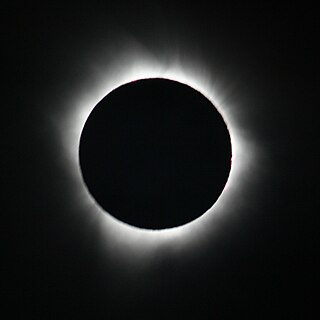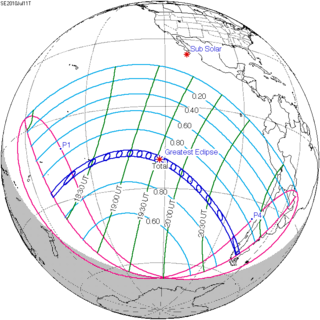Solar eclipse of July 11, 2010
| Solar eclipse of July 11, 2010 | |
|---|---|

Totality from Hao, French Polynesia
|
|
| Type of eclipse | |
| Nature | Total |
| Gamma | -0.6788 |
| Magnitude | 1.058 |
| Maximum eclipse | |
| Duration | 320 sec (5 m 20 s) |
| Coordinates | 19°42′S 121°54′W / 19.7°S 121.9°W |
| Max. width of band | 259 km (161 mi) |
| Times (UTC) | |
| (P1) Partial begin | 17:09:41 |
| (U1) Total begin | 18:15:15 |
| Greatest eclipse | 19:34:38 |
| (U4) Total end | 20:51:42 |
| (P4) Partial end | 21:57:16 |
| References | |
| Saros | 146 (27 of 76) |
| Catalog # (SE5000) | 9530 |
The total solar eclipse of July 11, 2010, occurred over the southern Pacific Ocean. A solar eclipse occurs when the Moon passes between Earth and the Sun, thereby totally or partly obscuring the image of the Sun for a viewer on Earth. A total solar eclipse occurs when the Moon's apparent diameter is larger than the Sun's, blocking all direct sunlight, turning day into darkness. Totality occurs in a narrow path across Earth's surface, with the partial solar eclipse visible over a surrounding region thousands of kilometres wide.
The eclipse on this day was one of the most remote in recorded history. It was visible over much of the southern Pacific Ocean, touching several atolls in French Polynesia, the Cook Islands, Easter Island, and Argentina's Patagonian plains.
Fred Espenak, a NASA astrophysicist, said:
"One of the most unique things about this particular eclipse is that it crosses a unique and interesting archaeological site: Easter Island. On Easter Island there are these great statues... There's a lot of mystery about these statues, but in any case, this is the first total eclipse to hit the island in about 1,400 years."
The best one occurred in French Polynesia, where it was seen in 98 percent, At the spectacular eclipse, The diamond ring effect and the Baily's beads happened.
It ended at sunset over the southern tips of Argentina and Chile in South America, including the town of El Calafate. The Sun's altitude was only 1° during the 2 minute 47 second total phase, but Argentino Lake offered an adequate line-of-sight to the eclipse hanging just above the rugged Andes skyline.
...
Wikipedia

